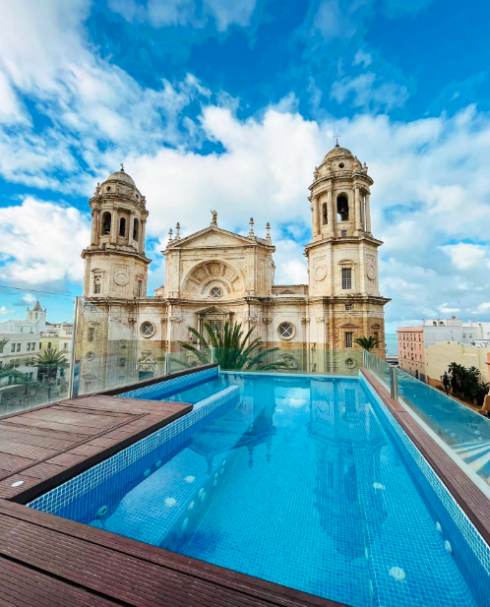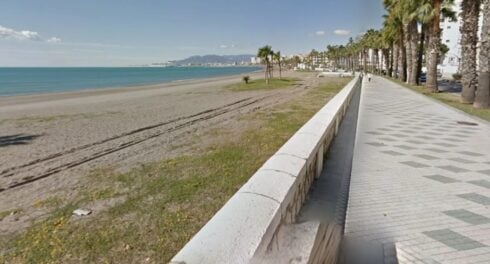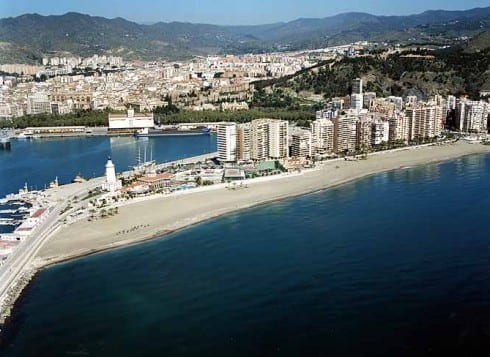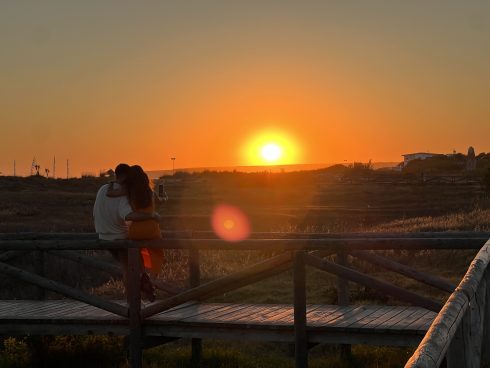THE city of Cadiz is on a peninsula, precariously attached to the rest of Spain by three strings: the glorious Puente de la Constitucion (known as ‘La Pepa’); the ho-hum, but sturdy Puente Jose Leon de Carranza (both on the east side) and a 3 km strip of the CA 33 from the south. (See it from above in our seagull’s eye view video).
Historically, people arrived by sea – first the Phoenicians back in 1100 BC, then the Carthaginians, Romans, Visigoths and Moors, before a flurry of explorers returned from the new world loaded up with boats full of treasure.
These riches would go on to fund the grandest of buildings of their time, including a series of towering houses with views to the sea, as well as a beautiful golden-domed cathedral.
But, the place was already a gem when it came to architecture.
As the oldest continuously-inhabited city in the Iberian Peninsula, pretty much everything is historic so you don’t necessarily need to visit the Museo de Cadiz (though you probably should, if time allows).
The second biggest Roman theatre in Spain is right there in the middle, uncovered during the excavation of a slightly newer building, while the underground foundations and sewers of the city can be seen in a fascinating museum.
WANDERING ABOUT

Exploring is easy in Cadiz. Mediaeval stone walls separate the shops, offices and condos of modern Cadiz, from the old part.
Once you’re through the Puerta de Tierra arch, you can follow the sea wall or dive into the cross-hatch of narrow streets and plazas and end up where you end up.
To get your bearings, head to Torre Tavira with its fascinating ‘camara oscura’ (on Calle Marques del Real Tesoro), which, at 33 metres, is the highest lookout tower in the city.
Protecting the city from pirates and raiders was a full-on job.
Hence the hefty looking Castillo de San Sebastian on a causeway from Playa La Caleta and the star-shaped Castillo de Santa Catalina built on the other side of the beach in 1598 and definitely worth a visit.
But these days, for all its popularity, old Cadiz is a surprisingly peaceful place with quiet, unexpected plazas and its dense botanical garden, Parque Genoves.
THE BEACHES
La Caleta, between the castles, is small and busy, and easy to access. It’s also beautiful with its 1920s spa, the bright, white balneario.

Playa Victoria, backed by condos and bars, and running along the western edge of modern Cadiz, is absolutely enormous, with chiringuitos and a neighbourly feel.
WHERE TO EAT & DRINK
The best place to eat, Codigo de Barra, quickly rose to become a gastro-institution and now holds a Michelin star. Dutch chef Leon Griffioen puts a new twist on Andalucian classics. Book ahead and try one of the tasting menus (Calle San Francisco, 7).
Also innovative and exciting are La Marmita (Calle Ancha, 7) and La Curiosidad de Mauro Barreiro (Calle Veedor, 10).
Taberna Almarcen, right by the market with outdoor tables for people-watching, has an ever-changing menu based on local fresh produce, as well as Jerez vermouth (Plaza Libertad). Others combining good food with great setting are Sonambulo with outdoor seating on Plaza de la Candelaria; and Garage Bistro, good for tapas, with outdoor seating on Calle Posadilla.
Fish and chips – except without the chips – is the Cadiz specialty, best taken away in a paper cone and eaten overlooking the beach (though most freidurías have seating and some are quite fancy).
All are good, but El Freidor del Mercado is easy to find, and Casa Manteca, founded in 1953, has a great traditional atmosphere (Calle Corralon de los Carros, 66), while Freiduria Las Flores is a firm favourite with a top selection (Plaza Topete, 4. Cádiz).
For a drink you’re spoilt for choice, but try Casa Manteca; and Taberna la Manzanilla for sherries from the barrel; the super-popular tapas bar La Tabernita on Calle Virgen de la Palma, 32, (tiny as the name suggests but with barrels to stand at outside); and – for a bit of sophistication and great views over La Caleta– the bar-restaurant Quilla.
WHERE TO STAY
It’s not the biggest or the swankiest, and it doesn’t have sea views, but Hotel Argantonio on a narrow street right in the centre is ideal for a short stay – a gem with prices that won’t break the bank.

Another good mid-priced option is Casa de los Cuatro Torres, just 700 metres from the Museo de Cadiz, airy and spacious but with exposed beams and ancient walls here and there.
A converted 17th century convent, Hotel Boutique Convento offers modern, somewhat bland rooms, but fabulous public spaces including cloisters, just five minutes from the city gate.
While, for rooftop swimming pool views, you can’t beat Hotel La Catedral which, as the name suggests, faces la cathedral. Those on a budget should check out the friendly Casa Caracol, a 5-minute walk away on Calle Suarez de Salazar.
READ MORE
Explore Spain: Travelling an Unspoilt Coast
Beach Guide: Costa de la Luz, Cadiz
Costa de la Luz: Where to Stay
Getting Around the Costa de la Luz
Click here to read more Olive Press Travel News from The Olive Press.








